Related Research Articles
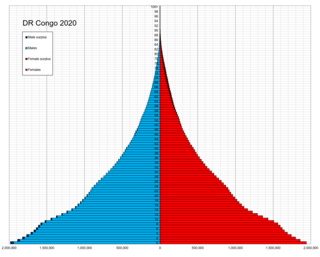
This article is about the demographic features of the population of the Democratic Republic of the Congo, including ethnicity, education level, health, economic status, religious affiliations and other aspects of the population.
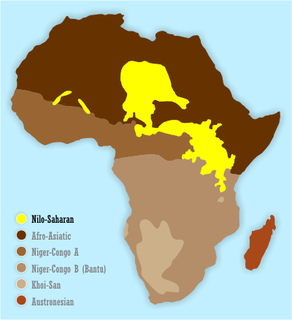
The Nilo-Saharan languages are a proposed family of African languages spoken by some 50–60 million people, mainly in the upper parts of the Chari and Nile rivers, including historic Nubia, north of where the two tributaries of the Nile meet. The languages extend through 17 nations in the northern half of Africa: from Algeria to Benin in the west; from Libya to the Democratic Republic of the Congo in the centre; and from Egypt to Tanzania in the east.
Nubians are an ethnic group indigenous to the region which is now northern Sudan and southern Egypt. They originate from the early inhabitants of the central Nile valley, believed to be one of the earliest cradles of civilization. In the southern valley of Egypt, Nubians differ culturally and ethnically from other Egyptians, although they intermarried with members of other ethnic groups, especially Arabs. They speak Arabic and Nubian languages, part of the Northern Eastern Sudanic languages.

In anthropology, pygmy peoples are ethnic groups whose average height is unusually short. The term pygmyism is used to describe the phenotype of endemic short stature for populations in which adult men are on average less than 150 cm tall.

The Bantu expansion is a hypothesis of major series of migrations of the original Proto-Bantu-speaking group, which spread from an original nucleus around Central Africa across much of sub-Saharan Africa. In the process, the Proto-Bantu-speaking settlers displaced or absorbed pre-existing hunter-gatherer and pastoralist groups that they encountered.

The Mbuti people, or Bambuti, are one of several indigenous pygmy groups in the Congo region of Africa. Their languages are Central Sudanic languages and Bantu languages.

The Aka or Bayaka are a nomadic Mbenga pygmy people. They live in southwestern Central African Republic and in northern Republic of the Congo. They are related to the Baka people of Cameroon, Gabon, northern Congo, and southwestern Central African Republic.

The Mangbetu are a Central Sudanic ethnic group in the Democratic Republic of the Congo, living in the northeastern province of Haut-Uele.
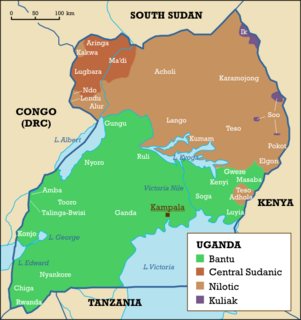
In Uganda the most spoken local language is Luganda as the Baganda tribe occupies the southern central part of Uganda and the capital city of the country, followed by English, as all schools in Uganda use it in their studies due to the introduction of English during the colonial period. English is also the language of business and judicial matters. Most spoken after Luganda and English is Swahili. This language is more common in neighbouring Kenya and Tanzania. Swahili is taught in schools as an optional additional language and it is mostly spoken by the Ugandan army. In 2005, there were talks to include Swahili into as the second official language as it was seen as neutral, however this is still not ratified by the government.
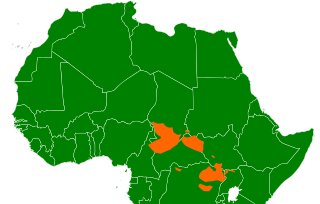
Central Sudanic is a family of about sixty languages that have been included in the proposed Nilo-Saharan language family. Central Sudanic languages are spoken in the Central African Republic, Chad, South Sudan, Uganda, Congo (DRC), Nigeria and Cameroon. They include the pygmy languages Efé and Asoa.
Geographical location of Bassari people
Mangbetu, or Nemangbetu, is one of the most populous of the Central Sudanic languages. It is spoken by the Mangbetu people of northeastern Congo. It, or its speakers, are also known as Amangbetu, Kingbetu, Mambetto. The most populous dialect, and the one most widely understood, is called Medje. Others are Aberu (Nabulu), Makere, Malele, Popoi (Mapopoi). The most divergent is Lombi; Ethnologue treats it as a distinct language. About half of the population speaks Bangala, a trade language similar to Lingala, and in southern areas some speak Swahili.
Lese is a Central Sudanic language of northeastern Congo-Kinshasa, as well as a name for the people who speak this language. The Lese people, live in association with the Efé Pygmies and share their language, which is occasionally known as Lissi or Efe.
Asoa, also known as Asua, Asuae, Asuati, or Aka, is a Central Sudanic language spoken by the Mbuti Pygmies known as the Asua. It is closely related to the Mangbetu language, and the Asua live in association with the Mangbetu people, among others. It is the only distinctive Pygmy language in the east.
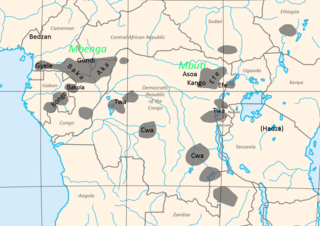
The Congo Pygmies are those "forest people" who have, or recently had, a hunter-gatherer economy and a simple, non-hierarchical societal structure based on bands, are of short stature, have a deep cultural and religious affinity with the Congo forest and live in a generally subservient relationship with agricultural "patrons", with which they trade forest products such as meat and honey for agricultural and iron products.
The Mangbetu–Asoa or Mangbetu languages of the Central Sudanic language family are a cluster of closely related languages spoken in the Democratic Republic of Congo.

The Bantu peoples, or Bantu, are an ethnolinguistic grouping of approximately 400 distinct ethnic groups who speak Bantu languages. They are native to 24 countries spread over a vast area from Central Africa to Southeast Africa and into Southern Africa. There are several hundred Bantu languages. Depending on the definition of "language" or "dialect", it is estimated that there are between 440 and 680 distinct languages. The total number of speakers is in the hundreds of millions, ranging at roughly 350 million in the mid-2010s. About 60 million speakers (2015), divided into some 200 ethnic or tribal groups, are found in the Democratic Republic of the Congo alone.

The African Pygmies are a group of ethnicities native to Central Africa, mostly the Congo Basin, traditionally subsisting on a forager and hunter-gatherer lifestyle. They are divided into three roughly geographic groups:

The Mangbetu is African tribe part of Democratic Republic of the Congo, living in the Orientale Province. The people of this tribe produced a large variety of highly developed art and music, such as harps, guitars, pots, and other crafts. Their pots are still prominent in today's art spectrum, and ones that have been constructed in the early days of the tribe are sold to collectors and people alike for high prices.

Mawlawi Abdul Salam Hanafi is an Afghan Uzbek political and Deobandi-Islamic religious leader who is a senior leader of the Taliban, an acting second deputy prime minister, alongside Abdul Ghani Baradar and Abdul Kabir, of Afghanistan since 2021, and was a central member of the negotiation team in the Qatar office. He has also served as deputy minister of education in the Taliban government from 1996-2001. After the Taliban government collapse in 2001, following the United States invasion of Afghanistan, Hanafi was appointed by the Taliban leadership as a top general to oversee the Taliban’s military activities in Jowzjan Province, Northern Afghanistan from May 2007 until sometime in 2008.
References
- ↑ "Asoa people - 2 definitions - Encyclo". www.encyclo.co.uk. Retrieved 2022-09-11.
- ↑ "Asoa people - 2 definitions - Encyclo". www.encyclo.co.uk. Retrieved 2022-09-11.